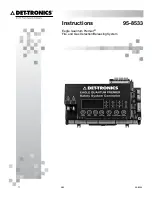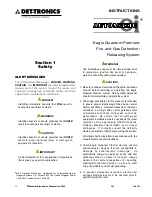
7.1
95-8533
2-4
note
All fault and alarm conditions are latched on the
Controller. to reset the Controller, conditions
indicated on the text display must currently be in
the oFF state. Pushing the reset button then
initiates a Controller reset. Active alarms will
remain through a Controller reset.
ContRoLLER LoGs
The controller has an internal alarm and event log.
The logs can be accessed via the S3 software
configuration ports (Configuration Port or Port 3) using
a RS-232 serial cable and a Windows™ computer.
The controller can save up to 4,095 alarms and events
in the controller memory.
ContRoLLER usER LoGiC
The Controller continuously executes the user logic
programs that are programmed using S3 software.
The user logic programs are set up in the same
fashion as IEC 61131-3 programmable logic
programmed into Programmable Logic Controllers
(PLCs). Block diagram logic gates are tied together
with inputs, outputs, and other logic gates to perform
a specific task. A number of tasks can be tied
together to perform a system function.
Typical programmed functions include flame/gas
voting, timing delays, timing executions, latching
conditions, alarm and trouble notification, suppression
control, condition control, and process shutdown
notification.
The Controller executes program logic by starting with
the first logic page of the first program and then
progressing onto subsequent pages of the same
program. In turn, subsequent programs are then
executed.
Every one hundred milliseconds, the Controller will
start executing the user logic that is programmed into
the Controller. Within this logic execution cycle, the
Controller will execute as many of the logic pages as
possible. If all programmed logic is executed in a
cycle, the Controller will start executing program logic
with the next cycle. Otherwise, subsequence logic
execution cycles are used to finish executing the
remaining logic gates. Only when all the logic gates
have been executed will the Controller start over. The
Controller will start executing the first logic page of
the first program at the beginning of the next logic
cycle.
CommuniCation nEtWoRK FauLt opERation
During normal operation, the Controller is continuously
broadcasting a heartbeat around the communication
loop as shown in Figure 2-2. The Controller
broadcasts the heartbeat in both directions. At the
same time, the field devices are transmitting status
information to the Controller over the communication
loop.
Every field device except the network extender has
two LON fault isolation relays. Each relay is tied to a
communication port on the device. When a field
device fails to receive the heartbeat from the
Controller, the device initiates a LON fault isolation
routine. The isolation routine disconnects one of the
communication ports via one of the LON fault isolation
relays. The device listens for a heartbeat on the
communication port that is connected. If a heartbeat
is not found, the routine then disconnects the other
communication port and listens for a heartbeat on the
connected side. The process is repeated until either
a heartbeat is located or a LON fault timeout period of
two hours is reached. The LON fault isolation routine
is disabled and the LON fault isolation relays are
closed when the LON fault timeout period has
elapsed. The LON fault isolation routine will be
enabled when the device again receives a heartbeat.
For a single wiring fault, the field devices with the fault
will isolate the fault by opening LON fault isolation
relays. After the field devices isolate the wiring fault,
communications will be resumed between the
Controller and field devices. Refer to Figure 2-3.
Figure 2-2—Normal Communication over the LON
Figure 2-3—Communication over the LON with a Single Wiring Fault
D1851
NODE 1
NODE 8
NODE 3
NODE 6
NODE 2
NODE 7
NODE 4
NODE 5
EQP
CONTROLLER
EAGLE QUANTUM PREMIER
Safety System Controller
DET
-
TRONICS
D1852
NODE 1
NODE 8
NODE 3
NODE 6
NODE 2
NODE 7
NODE 4
NODE 5
PATH A
PATH B
WIRING FAULT
EQP
CONTROLLER
EAGLE QUANTUM PREMIER
Safety System Controller
DET
-
TRONICS
Summary of Contents for DET-TRONICS 95-8533
Page 128: ...7 1 95 8533 A 4 Figure A 1 System Drawing 007545 001 ...
Page 129: ...95 8533 A 5 7 1 Figure A 2 System Drawing 007545 001 ...
Page 131: ...95 8533 7 1 B 2 Figure B 1 Drawing 007546 001 ...
Page 132: ...95 8533 7 1 B 3 Figure B 2 Drawing 007546 001 ...
Page 134: ...95 8533 7 1 C 2 Figure C 1 Drawing 007547 001 ...
Page 141: ...95 8533 7 1 D 7 Figure D1 System Drawing 007545 001 ...
Page 143: ...APPENDIX E E 1 95 8533 7 1 ...











































